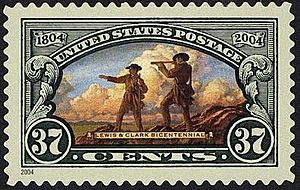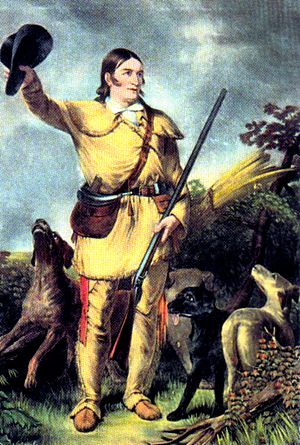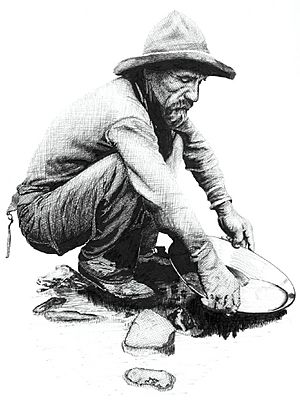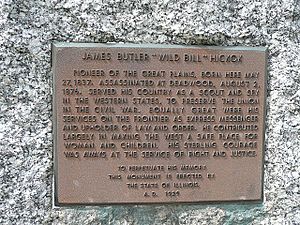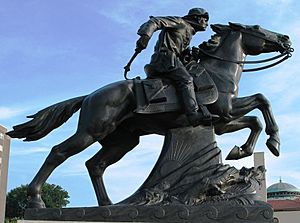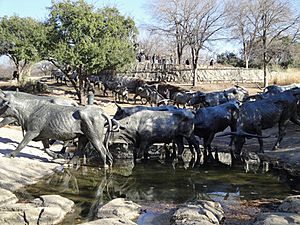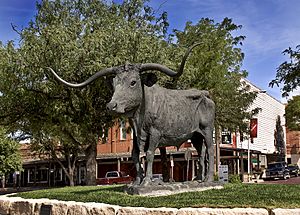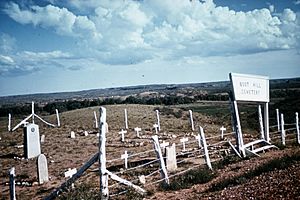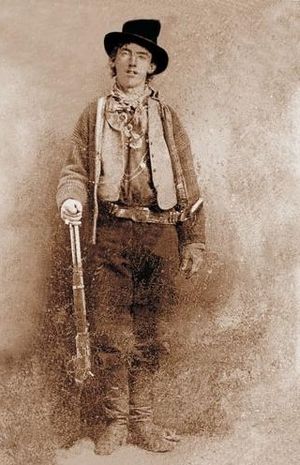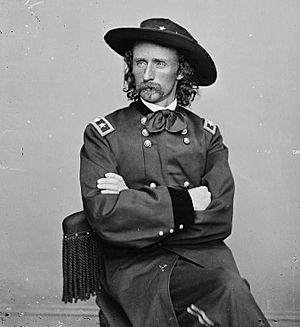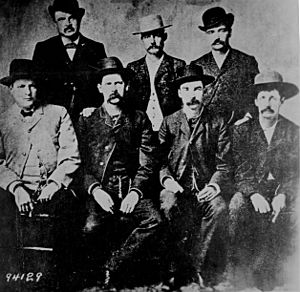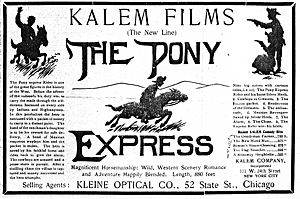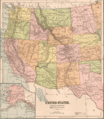American Old West facts for kids
Quick facts for kids 
The cowboy, the classic symbol of the American frontier, around 1887
|
|
| Date |
|
|---|---|
| Location | Currently the United States, historically in order of their assimilation:
|
The American Old West is a period in United States history when the western parts of North America were being explored and settled. It mostly refers to the late 19th century. People also call it the Old West or Wild West.
This time was full of adventure and challenges. It has become a big part of American history and fiction. The Old West describes life beyond the settled areas, known as the "Frontier Strip."
Contents
- What Was the Old West Like?
- Life Before European Settlers Arrived
- Early Explorers and Trappers
- Important Trails and Routes
- Davy Crockett: King of the Wild Frontier
- The Gold Rush and Civil War Era
- Life in the Wild Wild West
- Dodge City: A Lawless Town?
- Wild Bill Hickok and Calamity Jane
- Lincoln County War
- Jesse James: The Outlaw Legend
- Western Indian Wars
- Gunfight at the O.K. Corral
- Buffalo Bill's Wild West Show
- The Old West in Movies and Books
- Western Movies: A Special Kind of Film
- Cool Facts About the American Old West
- Images for kids
- See also
What Was the Old West Like?
Many stories about the Old West focus on exciting events. In Western movies and books, the Old West is often shown as a dry land. It was home to many different kinds of people, including:
- Cowboys and Native Americans
- Lawmen who kept order
- Outlaws who broke the law
- Gold miners searching for riches
- Trappers who hunted animals for their furs
- Explorers who discovered new lands
Conflicts often happened over water. Land without water was not very useful in the dry western states. Many gold rushes happened in the Old West. This caused a fast movement of people to the frontier. Everyone hoped to find gold and get rich.
Life Before European Settlers Arrived
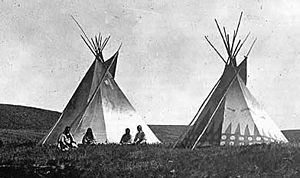
Long before Europeans came, many Native American tribes lived in America. The Kiowa and other Plains tribes lived on the Great Plains. Important Plains tribes included the Dakota, Blackfoot, Cheyenne, Lakota, and Comanche.
There was a lot of wild game, especially huge herds of buffalo. In the southwest, the Apache and Navajo lived in dry but fertile lands. These tribes traveled and hunted from the Mississippi River to the Rocky Mountains. Their lands stretched from Mexico's border up into Canada.
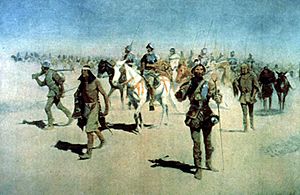
In 1541, Francisco Vázquez de Coronado explored the central part of America. Later, in 1776, Commander Anza led nearly 300 settlers and soldiers across deserts. They were looking for a better life on the edge of the Spanish Empire.
The Louisiana Purchase in 1803 greatly expanded the western borders of America. This opened up vast new territories for exploration and settlement.
Early Explorers and Trappers
The Lewis and Clark Expedition (1804–1806) was the first U.S. journey across the western frontier. Captain Meriwether Lewis and Second Lieutenant William Clark led this group all the way to the Pacific coast and back.
Mike Fink, a famous river-boatman, was another early frontiersman. He explored the Old West and was known for trapping. He is believed to have died around 1823 in the Rocky Mountains.
Important Trails and Routes
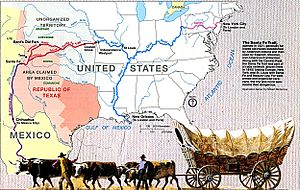
Many trails helped people travel west. William Becknell opened the Santa Fe Trail in 1821. This trail was used for trade between Missouri and New Mexico until 1880.
Bent's Fort was built on the Santa Fe Trail in 1833. It was a major trading post for Southern Cheyenne and Arapaho Indians. They traded buffalo robes there.
The Old Spanish Trail was another trade route. It started in New Mexico and went through Colorado, Utah, and Arizona to California.
The Southwest Trail was the main route for American settlers going to Texas.
The Mormon Trail was used by Mormon pioneers. They traveled from Illinois to Salt Lake Valley, Utah, where they founded Salt Lake City in 1846.
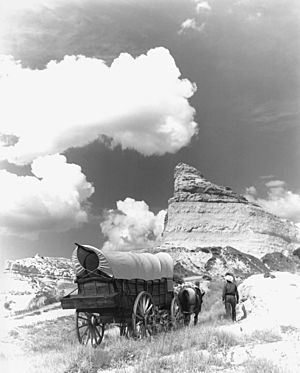
The Oregon Trail is one of the most famous pioneer trails. It stretched over 2,000 miles through lands that became six U.S. states. This trail helped the United States grow across the continent.
The California Trail shared part of the Oregon Trail's route. It was used by 250,000 farmers and gold-seekers. They traveled to California's gold fields and farms starting in the late 1840s.
Davy Crockett: King of the Wild Frontier
Davy Crockett was a famous American frontiersman, soldier, and politician. He was known as the "King of the Wild Frontier." He served in the U.S. House of Representatives for Tennessee.
In 1835, after losing an election, Crockett moved to Texas. He joined the Texas Revolution in 1836. He and 65 other men promised to fight for Texas. Each man was promised a large amount of land.
Crockett arrived at San Antonio de Bexar in February 1836. He fought in the Battle of the Alamo. He was assigned to defend the south wall. The Texas forces were greatly outnumbered by Mexican soldiers. Tradition says Crockett fought bravely until the end inside the Alamo.
The Gold Rush and Civil War Era
When gold nuggets were found near Sacramento, California, many people rushed west. This became known as the California Gold Rush. From 1848 to 1858, people flooded into Northern California. The busiest year was 1849, and these gold-seekers were called the '49ers.
James Butler Hickok, known as "Wild Bill," was a stagecoach driver on the Santa Fe and Oregon Trails. He was famous for his gun-fighting skills. He later became a lawman and was known for capturing the McCanles gang by himself.
The Pony Express was a mail service that ran from Missouri to California. It was 1,840 miles long and crossed several states and territories. It only operated for 18 months, from April 1860 to October 1861.
When the Civil War began in 1861, Kit Carson joined the New Mexico volunteer infantry. He fought in the Battle of Valverde in the New Mexico Territory.
Life in the Wild Wild West
As the eastern U.S. was becoming more industrial, the western frontier was filling up. Much of the land was open for livestock grazing and homesteading.
In many parts of the Old West, there was little law enforcement. The military only had a few bases. Buffalo hunters, railroad workers, and soldiers often fought. In towns, businesses, dance halls, and saloons served those involved in the Texas cattle drive trade.
The historic Chisholm Trail was used for cattle drives. It ran 800 miles from South Texas to Abilene, Kansas. From 1867 to 1887, cowboys drove cattle north to the Kansas Pacific Railway for shipment east. The trail was named after Jesse Chisholm, who had built trading posts.
Cattle drivers had to watch out for cattle rustlers, or thieves. Both Americans and Mexicans were known for stealing cattle.
Dodge City: A Lawless Town?
Fort Dodge, Kansas, was established in 1859. It opened in 1865 on the Santa Fe Trail, near where Dodge City, Kansas was founded in 1872. The fort protected wagon trains and mail service. It also supplied troops fighting in the Indian Wars.
By late 1872, Dodge City became famous for its lawlessness and gunfights. But soon, respectable law officers like Bat Masterson, Wyatt Earp, and Bill Tilghman brought order. The city passed a law that guns could not be carried north of the railroad tracks. The south side, however, remained "wide open." Fort Dodge closed in 1882, and cattle drives ended after a big blizzard in 1886.
Wild Bill Hickok and Calamity Jane
After the Civil War, Wild Bill Hickok became an army scout and a professional gambler. He was known for his sharpshooting skills.
In 1876, Calamity Jane settled in Deadwood, South Dakota. She was close friends with Wild Bill Hickok and Charlie Utter.
On August 2, 1876, Hickok was playing poker. He usually sat with his back to a wall for safety. But this time, he had to sit with his back to the door. He was shot and killed by Jack McCall.
In 1876, Calamity Jane helped care for people during a smallpox outbreak in Deadwood. She later married Clinton Burke in 1891.
Lincoln County War
The Lincoln County War (1877) was a conflict between two powerful groups in Lincoln County, New Mexico. One group was led by wealthy ranchers, and the other by the rich owners of the local general store.
Billy the Kid was a famous outlaw and fighter who sided with the ranchers. He became well-known during this conflict.
Jesse James: The Outlaw Legend
The criminal Jesse James was very famous in the Old West. Newspapers helped make him a legend, sometimes making him seem like a Robin Hood figure.
James and his gang robbed banks, trains, stagecoaches, and stores across the Western frontier. They stole thousands of dollars. Even the Pinkerton National Detective Agency could not catch them. James is believed to have carried out the first daylight bank robbery during peacetime, stealing $60,000 from a bank in Liberty, Missouri.
Western Indian Wars
The Apache and Navajo Wars (1861–1886) involved Kit Carson fighting the Apache around reservations. Skirmishes continued until 1886, when Geronimo surrendered.
Kit Carson used a "scorched earth" tactic in the Navajo campaign. He burned Navajo fields and homes and took or killed their animals. Other Indian tribes, like the Utes, helped him. He also fought a combined force of Kiowa, Comanche, and Cheyenne at the First Battle of Adobe Walls.
Red Cloud's War (1866–1868) was led by the Lakota chief Red Cloud. This was the most successful war against the U.S. during the Indian Wars.
By the Treaty of Fort Laramie (1868), the U.S. gave a large reservation to the Lakota. This land was to have no military presence or American settlements. The U.S. government also promised not to build roads there. The reservation included the entire Black Hills.

Captain Jack was a chief of the Modoc tribe. He led his 53 warriors against 1000 U.S. Army soldiers for seven months during the Modoc War (1872–1873). Captain Jack killed General Edward Canby, the only general killed during the Indian Wars.
The Black Hills War (1876–1877) involved the Lakota under Sitting Bull and Crazy Horse. This conflict started because the U.S. government broke the 1868 treaty. They kept trying to take back the Black Hills from the Lakota.
One famous battle was the Battle of the Little Bighorn (1876). Sioux and Cheyenne warriors, led by Sitting Bull and Crazy Horse, defeated the 7th Cavalry. This cavalry was led by George Armstrong Custer.
The Indian Wars ended with the Wounded Knee Massacre (December 28, 1890). About 200 Sioux, including Sitting Bull's half-brother, Big Foot, were killed by the U.S. 7th Cavalry. Sitting Bull himself had been killed just days before by Indian police sent to arrest him.
Gunfight at the O.K. Corral
The Gunfight at the O.K. Corral is a legendary event from the Wild West. It happened on October 26, 1881, in a vacant lot behind a corral in Tombstone, Arizona.
Thirty shots were fired in just thirty seconds. Wyatt Earp, Doc Holliday, Virgil Earp, and Morgan Earp fought against the Clanton and McLaury brothers. Two McLaurys and Billy Clanton were killed in the fight.
Buffalo Bill's Wild West Show

William Frederick "Buffalo Bill" Cody was a famous frontiersman and showman. He toured the United States in plays based on his Western adventures.
In 1883, Cody started the "Buffalo Bill Wild West Show" in Omaha, Nebraska. This was a circus-like show that toured every year. Famous people like Annie Oakley and Sitting Bull appeared in the show.
In 1887, he performed in London for Queen Victoria's Jubilee. He also toured Europe in 1889.
The Old West in Movies and Books
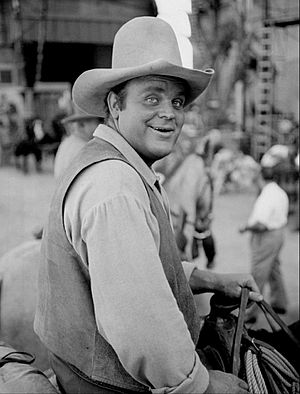
Famous Old West places and characters are often shown in fictional movies and television shows. Examples include Gunsmoke and Bonanza.
For instance, Dodge City, Kansas, was a real town. Bat Masterson and Wyatt Earp were real lawmen there. But characters like Marshall Matt Dillon from Gunsmoke are fictional. Similarly, Virginia City, Nevada, was a real mining town. But the Ponderosa Ranch and the Cartwright family from Bonanza are made up.
Other famous "Wild West" stories include movies like Butch Cassidy and the Sundance Kid, Shane, and High Noon. The novel The Virginian is another example.
The TV series Deadwood has also made the American Old West popular again in recent times.
Western Movies: A Special Kind of Film
Western films are usually set in the American West during the 1800s. They often tell stories about exploring the wilderness or fighting over land rights. These movies often show the struggles of taking land from the people who lived there first.
The popularity of Western movies has changed over time. As the U.S. gets further from the 1800s, the genre has become less popular.
Actors like Tom Mix, Hopalong Cassidy, Gene Autry, and The Lone Ranger often filmed near Lone Pine, California. Over 300 movies have been filmed there since the early 1920s.
John Ford was a director who filmed on location instead of in Hollywood. He took his crew to Monument Valley to film movies like Stagecoach (1939). He loved the scenery there, even if it wasn't the exact historical location.
Filming also started in Old Tucson, Arizona, in the late 1930s. More than 300 Western movies have been made there.
A type of Western film called Spaghetti Westerns started in the mid-1960s. These movies were made with smaller budgets and often filmed in different countries.
Cool Facts About the American Old West
- In 1799, a boy in North Carolina found a large gold nugget. This was 49 years before the famous California Gold Rush of 1848.
- In 1856, the U.S. Camel Corps suggested using camels as army pack animals in the Southwest. But the U.S. Army said no to the idea.
- The body of Maine outlaw Elmer McCurdy traveled the U.S. in shows and carnivals from 1916 until 1977. It was finally buried in California.
- Acoma Pueblo in New Mexico is the oldest settlement in the United States. It is 457 years older than Jamestown.
- Confederate forces fought at Fort Union, near Santa Fe, during the Civil War. They were defeated by the Union army.
- Outlaws were often photographed after they were killed. This was to show the public they were truly dead. It also served as proof to collect rewards.
- Even though movies don't always show it, African American cowboys made up about 25% of all cowboys in the Old West.
- The first woman to rob a stagecoach without being killed was Pearl Hart. She was pardoned after 18 months because there was no proper prison for women.
Images for kids
-
Daniel Boone escorting settlers through the Cumberland Gap
-
Siege of Fort Detroit during Pontiac's Rebellion in 1763
-
Map of the Wilderness Road by 1785.
-
Thomas Jefferson was interested in expanding and exploring the West.
-
Fur trading at Fort Nez Percés in 1841
-
Plate from Audubon's Birds of America
-
The first Fort Laramie as it looked before 1840. Painting by Alfred Jacob Miller
-
Sam Houston accepting the surrender of Mexican general Santa Anna, 1836
-
General Kearny's annexation of New Mexico, August 15, 1846
-
Clipper ships took 5 months to sail the 17,000 miles (27,000 km) from New York City to San Francisco
-
400,000 men, women, and children traveled 2,000 miles (3,200 km) in wagon trains during a six-month journey on the Oregon Trail
-
The Handcart Pioneer Monument, by Torleif S. Knaphus, located on Temple Square in Salt Lake City, Utah
-
Map of Pony Express route
-
Settlers escaping the Dakota War of 1862
-
Camp Supply Stockade, February 1869
-
Homesteaders, around 1866
-
Emigrants Crossing the Plains, 1872, shows settlers crossing the Great Plains. By F. O. C. Darley and engraved by H. B. Hall.
-
Sioux Chief Sitting Bull
-
Crow Chief Plenty Coups
-
Indian battles in the Trans Mississippi West (1860–1890)
-
"The Awakening" Suffragists were successful in the West; their torch awakens the women struggling in the North and South in this cartoon by Hy Mayer in Puck February 20, 1915
-
Temporary quarters for Volga Germans in central Kansas, 1875
-
A Buffalo Soldier. The nickname was given to the black soldiers by the Native tribes they controlled.
-
The Spanish mission of San Xavier del Bac, near Tucson, founded in 1700
-
A classic image of the American cowboy, as portrayed by C.M. Russell
-
1908 editorial cartoon of President Theodore Roosevelt features his cowboy persona and his crusading for conservation.
-
Wounded buffalo, by Alfred Jacob Miller
-
The Searchers, a 1956 film portraying racial conflict in the 1860s
See also
 In Spanish: Viejo Oeste para niños
In Spanish: Viejo Oeste para niños


